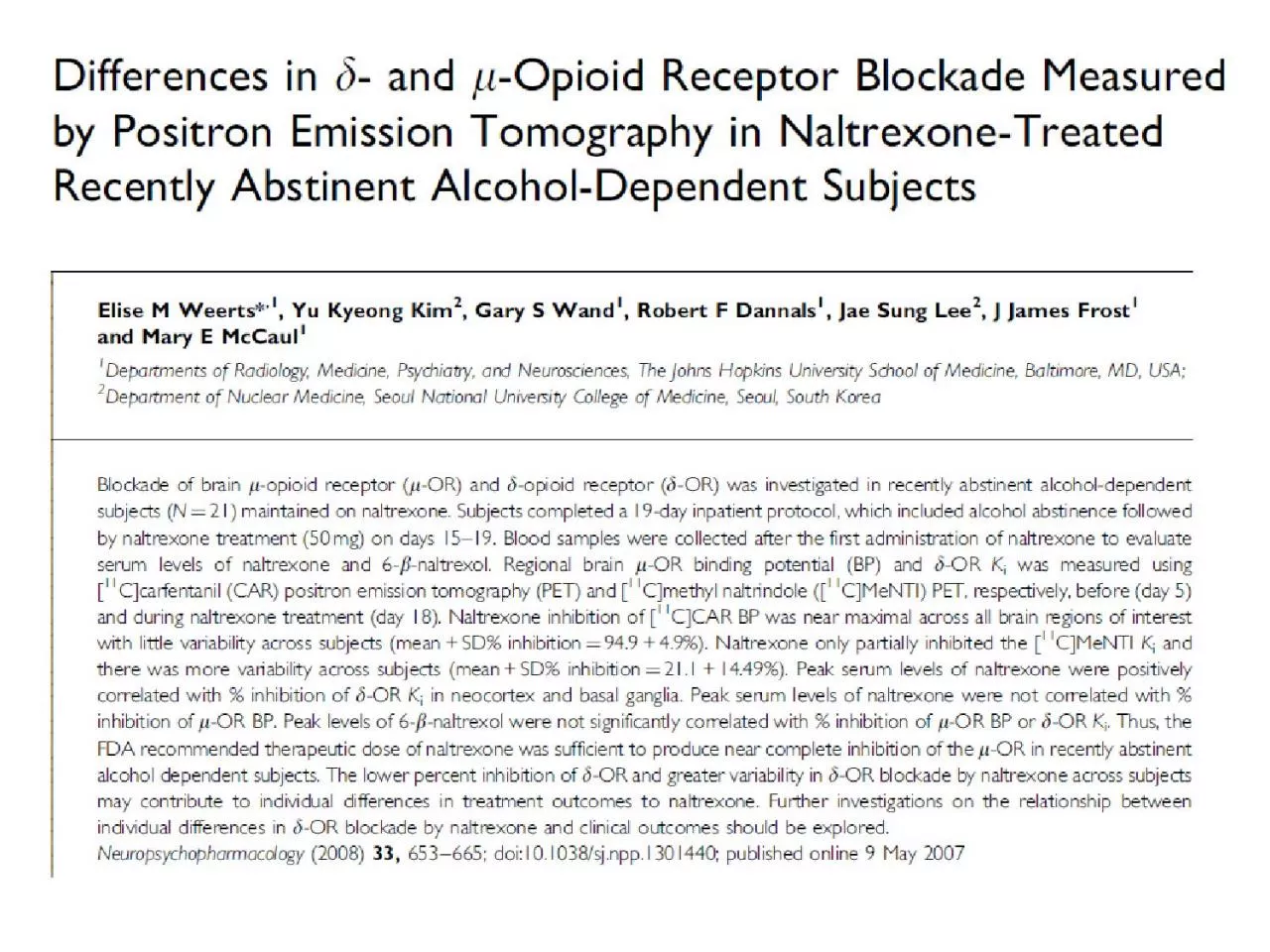

11 Ccarfentanil PET before and during naltrexone treatment Naltrexone inhibition of 11 Ccarfentanil BP was near maximal across all brain regions of interest with little variability across subjects ID: 933456
Download Presentation The PPT/PDF document "Regional brain MOR binding potential (BP..." is the property of its rightful owner. Permission is granted to download and print the materials on this web site for personal, non-commercial use only, and to display it on your personal computer provided you do not modify the materials and that you retain all copyright notices contained in the materials. By downloading content from our website, you accept the terms of this agreement.
Slide1
Slide2Slide3Regional brain MOR binding potential (BP) … using
11
C-carfentanil PET …before and during naltrexone treatment.
Naltrexone inhibition of
11
C-carfentanil BP was near maximal across all brain regions of interest with little variability across subjects
.
Slide4Study Design
1 5 10 15 18 19
Slide5days of abstinence
Study Design
1 5 10 15 18 19
Naltrexone
11C-MeNTI
11C-Carfentanil
11C-Carfentanil
11C-MeNTI
bolus
bolus
bolus
bolus
Slide6O
ccupancy of MOR by Naltrexone
Weerts et al., 2008
Slide7Clinical doses of NTX occupy ~100% of MOR in (recently abstinent) alcoholics
MOR = Mu Opiate Receptor
Weerts
et al., 2008
Individual Subjects
Slide8what are these images? not BP. why?
Slide9irreversible… means k4 = ?
so BP = ?
so is BP a good index to measure?
Instead, we measure
K1*k3
--------- …. what does this represent?
k2 + k3
what about this K1 * k3
--------
k2 + k3
think probability…
Slide10Hmmm…
If it ain’t MOR…and if it ain’t DOR…maybe its KOR?But to test it,
we need a kappa-specific ligand.
Slide11Conclusions
Slide12Talbot et al., JNM, 2005
Slide13New Tracer Summary: [
11C]MKAP & [11C]PKAB, KOR agonist & antagonist Yale PET Center
Chemistry
Autoloop (FxC)
Radiochemical Yield:
60 - 100 mCi (EOS)
5-7%
High Specific Activity
> 10 Ci/µmol @ EOS
Low mass limit (0.01 µg/kg)
Inject ~ 10 mCi
New process
Old process
Specific Act. (n = 12)
0.96 ± 0.38 mCi/nmol
Specific Act. (n = 30)
8.65 ± 3.14 mCi/nmol
Slide14New Tracer Summary: [
11C]MKAP & [11C]PKAB, KOR agonist & antagonist Yale PET Center
Activity summed from 40-60 min post-injection from a male subject, normalized by injected dose.
Cool Image
MR
PET
Slide15New Tracer for KOR
Several OR radiotracers are currently available for PET in humans including
11
C-carfentanil,
11
C-diprenorphine,
11
C-buprenorphine,
18
F-cyclofoxy, and 11C-naltrindole but none is selective for the KOR.
Slide16New Tracer Summary: [
11C]MKAP & [11C]PKAB, KOR agonist & antagonist Yale PET Center
Tracer InformationKOR Antagonist
Tracer name: [
11
C]PKAB
aka
LY2879788
Endogenous ligand:
Dynorphin
Slide17New Tracer Summary: [
11C]MKAP & [11C]PKAB, KOR agonist & antagonist Yale PET Center
Chemistry
H
11
CN
dppf, Pd
2
dba
3
, KHCO
3
DMF, 80 °C, 5 min
NaOH, H
2
O
2
80 °C, 5 min
11
CO
2
11
CH
4
NH
3
, Pt
950 °C
H
2
, Ni
350 °C
Cyanation
Hydrolysis
[
11
C]PKAB
Precursor
Intermediate
Radiochemical Yield:
81.0 ± 30.6 mCi (n = 14)
Specific Activity (EOS):
1.18 ± 0.36 mCi/nmol (n = 14)
Slide18New Tracer Summary: [
11C]MKAP & [11C]PKAB, KOR agonist & antagonist Yale PET Center
Cool Image
MR
SRTM2_120
SRTM2_90
BP
ND
images for a single subject computed using the SRTM2
method and data of 120 and 90 min post-injection.
Slide19Slide20design
?
GCRC
?
3$ 3$ 3$ 3$
Slide21Slide22Alcohol Self-Administration Model
(O’Malley, Krishnan-Sarin et al., 2002)
4 pm
Choice Block #1
5:00 pm
Outpatient
Treatment
Priming Drink
Alcohol Reactivity
craving
Ad-Lib Period
4 drinks per choice period (.015 g/dl)
$12 tab per choice period
(.03 g/dl)
Naltrexone
pretreatment
Choice Block #2
6:00 pm
7 pm
Day 0
Day 6
Day 7
MET Intervention Discharge
Slide23Slide24Get out some paper and a pen
you design a PET study to test the finding(s) in Krishnan-Sarin et al.